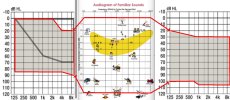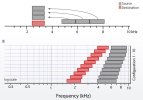pvc
Well-Known Member
- Joined
- Apr 12, 2023
- Messages
- 2,777
- Reaction score
- 710
I am trying to visualize-and-simplify the function of the typical (Compression and Amplification) software algorithms used in hearing aids for correcting a hearing loss. Insomuch as I understand the problem to be corrected, a HoH person has lost the ability to hear the full (decibel-range/intensity/loudness) from zero to 120 dB. So the low intensity sounds such as whispers are gone (can't hear them) and maybe even the moderate intensity sounds are difficult to hear.
Yes, the hearing loss may also vary in Frequency/Pitch in cycles per second (Hz). But for the sake of simplicity, I would like to focus on the ability to hear the full (decibel-range/intensity/loudness) from zero to 120 dB.
The below middle image (speech banana) represents the full (decibel-range/intensity/loudness) from zero to 120 dB to describe the intensity/loudness of certain sounds, and it also represents the Frequency/Pitch (from 125 to 8000 Hz which we are ignoring for now).
The below Left image represents an Oticon 85 receiver for a moderate hearing loss (ignore the dark gray lines for now which attempt to show the difference between an open vent fit and an occluded sealed-or-small-vent fit). For the power=85 receiver, the full (decibel-range/intensity/loudness) from zero to 120 dB will be compressed and sufficiently amplified to fit into a range of (zero to 85) dB.
The below Right image represents an Oticon 105 receiver for a severe or profound hearing loss. The full (decibel-range/intensity/loudness) from zero to 120 dB will be compressed and amplified to fit into a range of 20 to 105 dB.

Yes, the hearing loss may also vary in Frequency/Pitch in cycles per second (Hz). But for the sake of simplicity, I would like to focus on the ability to hear the full (decibel-range/intensity/loudness) from zero to 120 dB.
The below middle image (speech banana) represents the full (decibel-range/intensity/loudness) from zero to 120 dB to describe the intensity/loudness of certain sounds, and it also represents the Frequency/Pitch (from 125 to 8000 Hz which we are ignoring for now).
The below Left image represents an Oticon 85 receiver for a moderate hearing loss (ignore the dark gray lines for now which attempt to show the difference between an open vent fit and an occluded sealed-or-small-vent fit). For the power=85 receiver, the full (decibel-range/intensity/loudness) from zero to 120 dB will be compressed and sufficiently amplified to fit into a range of (zero to 85) dB.
The below Right image represents an Oticon 105 receiver for a severe or profound hearing loss. The full (decibel-range/intensity/loudness) from zero to 120 dB will be compressed and amplified to fit into a range of 20 to 105 dB.

Last edited:



